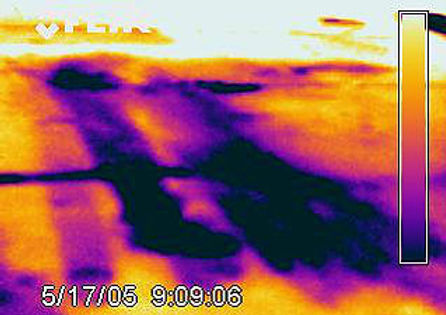

Water & Moisture Infiltration, Condensation and Flooding Problems
Water and Moisture Infilltration, Condensation and Flooding Problems
Chilled water systems, re-circulated systems, static water systems and potable water systems are all found in a building, home or facility. Water condensation and leaks on mechanical systems can create problems in the indoor environment. Excessive moisture may lead to thermal comfort complaints, and possibly microbial growth.
Infrared Thermography
State- of- the-Art Dignostic Tools
We feature the use of FLIR Infrared Thermal Imaging Cameras during our building assessments and evaluations for moisture damage, water infiltration & leaks, heat/thermal loss, and insulation surveys.
Infrared cameras offer a noninvasive means of monitoring and diagnosing the condition of buildings. It provides immediate non-destructive documentation of as-built or post-restoration quality, casualty cause, origin and extent data, plumbing and building envelope water leakage, post-flood and fire water-damaged material assessment, energy use inefficiency, roofing, and even rodent or pest discovery.
Structural System Problems
Roof leaks water-infiltration is usually the result of heavy rain on an old building roof. Buildings may also experience other infiltration routes, such as cracks in the building envelope, and/or its foundation. Older buildings were often built without semi-permeable moisture barriers (such as Tyvek film) on the walls, or a water barrier (such as polyethylene sheet) under the foundation slab. These may give rise to excesive interior moisture, which may promote microbial growth. Infrared cameras can detect and diagnose many of these otherwise "invisible" problems.
The image below shows the presence of moisture and the extent of the damage with the use of picture-in-picture, infrared-over-digital images, and environmental conditions (temperature & relative humidity) in the area.

The images below show the result of the wicking effect of drywall that has absorbed water in a flooded residence, due to a pipe leak. The resulting mold growth is readily seen on the lower portion of the wall. However, additional mold growth had colonized the entire interior wall cavity, requiring the total gutting of the residence.


The images below show a relatively new building, with a failing rubberized room membrane. The roof sustained some damage during an uncommon Florida hail storm. The resulting damage led to actual "indoor rain", and subsequent damage to equipment, computers, furnishings, carpets, and various building finishes. The thermal imaging camera was invaluable in the quick determination of the nature and extent of the damage, which was quickly addressed and repaired.


The images below show two areas of water infiltration at a faux chimney; the chimneys base, due to bad flashing work, and the chimney's frame, due to poor and very porous mortar work. The gray areas on the chimney and the roof are the entry point for the moisture.


The images below show two areas of concern. The window was obviously leaking, allowing for the channeling of water to the baseboard and carpet areas. However, a second area of concern is visible on the thermogram, to the left of the window. This resulted from water damage on the floor above, due to similar windows water infiltration. The windows were poorly caulked originally, leading to water intrusion.


